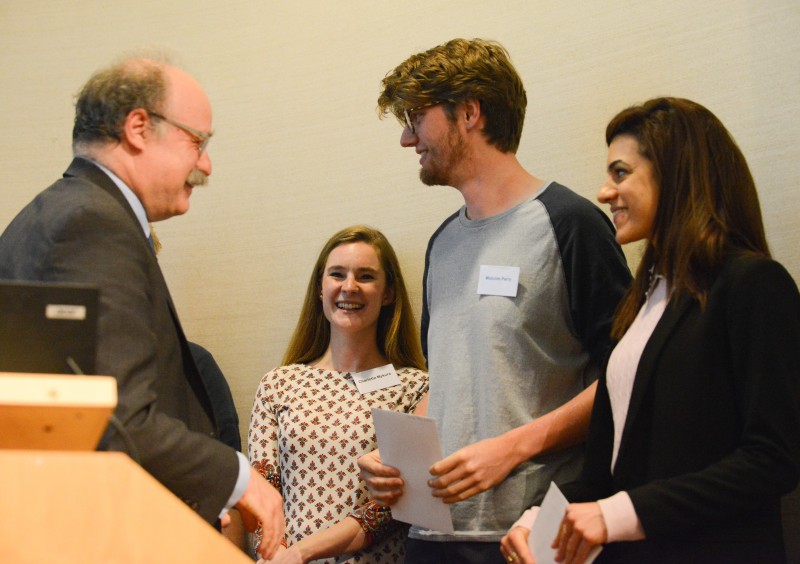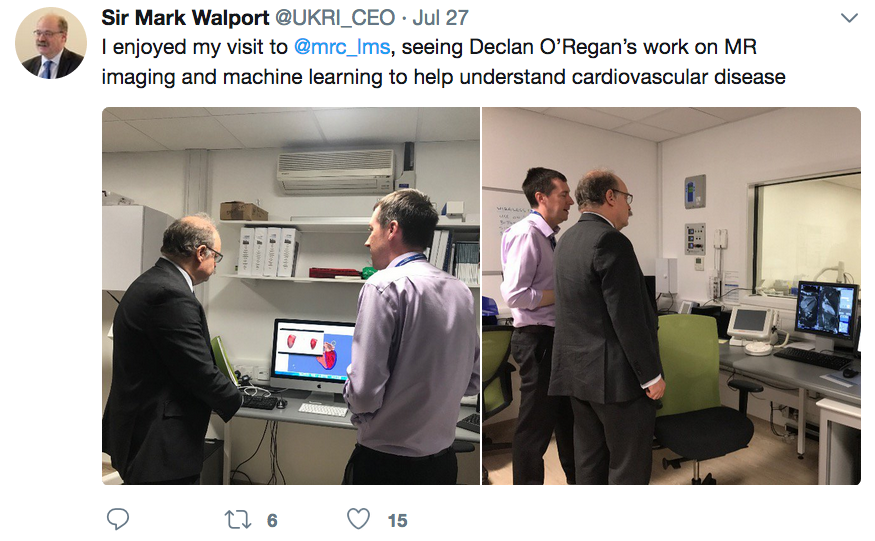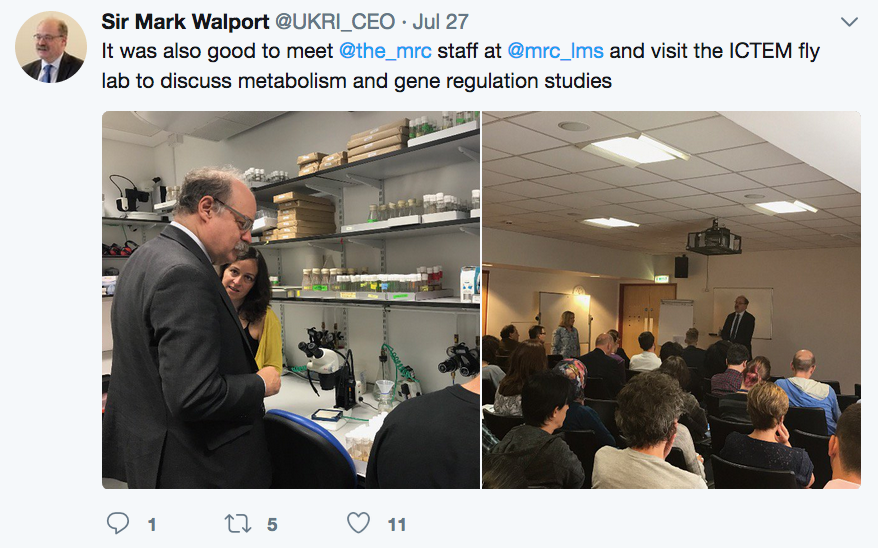By Susan Watts and Charlotte Davison
It was a day of scientific treats, student dynamism and guest appearances from the worlds of science and science policy. This year’s Institute Retreat, at the Royal Society in London, was a chance to celebrate the research of the LMS, and to formally launch the institute’s new name and new chapter.
Professor Emmanuelle Charpentier, co-creator of the CRISPR-Cas9 gene editing technique and director of the Max Planck Institute for Infection Biology in Berlin, rounded off a day of scientific talks with her keynote address. Professor Alice Gast, president of Imperial College London, and Professor Sir John Savill, Chief Executive of the Medical Research Council, spoke about their respect for the work of the LMS and its leadership – as leaders themselves of the institute’s two parent organisations.
Professor Sir Mark Walport, chief executive designate of UKRI (the new umbrella organisation for science funding in the UK), was special guest for the evening’s celebrations. Strict rules dictate what public servants can discuss in the run up to an election, and this was General Election Day 2017. Nevertheless, Sir Mark delivered a thoughtful talk, with two key themes. First, the power of clear communication, and second, the evolution of science as an increasingly multi-disciplinary source of solutions for a society facing multiple global challenges.

Mark Walport thanks the “Flash Talk” team at LMS Retreat 2017
Alice Gast congratulated Dame Mandy Fisher for her leadership of the Institute, since she became director in 2008, adding: “it’s not just Mandy of course… it’s really about the people, all of you here, the 30 research groups, 300 scientists and support staff that really make this such a powerful organisation and a very effective one. In the decade between 2006-2015, these research groups published some 1200 research papers with very high acclaim and citations.”
“The work of the institute is recognised and supported by some very important organisations not just the MRC, but also the Wellcome Trust, the British Heart Foundation, Cancer Research UK and the European Research Council, and it really is important that we thank all of those supporters for believing in what we are doing and coming together and making this so much more than the sum of the parts.”
“Of course we also have work of the Chain-Florey Clinical Research Training fellowship, which is really very important to us, and has helped bring young clinicians into PhD research. And I first got to know the group through the public engagement and the Suffrage Science award. We’re so pleased also that the LMS is so integrated with our department of computing, that you also have a mathematician in residence and that we are able to work across the disciplinary boundaries so effectively. The work is so compelling and our colleagues in other departments are so eager to work with you.”
Until January 2017, the LMS was known as the Clinical Sciences Centre. Sir John described the choice of LMS as the institute’s new name. “We focussed on the fact that this is an Institute. And what is an institute? It’s a big investment, it’s interdisciplinary, it involves lots of scientists at various different stages of development, it’s directed by an inspirational person who has power of it. The LMS is funded by the MRC, so it does medical science, and it’s in London – a great international city. So I want to really look forward to the next 25 years of this investment as the Laboratory of Medical Sciences.”
Immediately preceding Sir Mark’s closing address, the institute’s students braved the stage for a series of “Flash Talks” of just three minutes, praised by many as the highlight of the day. Armed with the brief that each talk should be charismatic, concise and jargon-free, Sasha Esin went first. He described how bacteria collect new genes from the environment. “If the genes are useful and are not disruptive to the genome they can be retained and passed on to future generations,” explained Esin.
Fresh from hospital and surgery on her spine, Charlotte Mykura described how the metal staples holding the skin together in her back were much like the protein complex, cohesin, that she studies. Simple but effective slides from Malcolm Perry provided a clear explanation of why and how our cell’s ensure that the right genes are “switched on” at the right time. And finally, Michelle Kokkinou spoke passionately about her work to develop an animal model for schizophrenia, to better understand the disease.
Sir Mark was clearly impressed. “My job at the moment is to be Chief Scientific Adviser to the Government, and in that role it’s all about communication,” Sir Mark explained. “And what I would say is that good communication is quite simply not an optional extra, it’s an intrinsic part of being a good scientist. You essentially haven’t finished your science until you’ve communicated it…and what we’ve just heard are four examples of very good, clear communication.”
“All too often, you hear scientists talking at scientific meetings who are completely failing to communicate to each other. A key part of my job is to de-mystify science, engineering, technology and social science. We heard earlier about the people with power and the money – well those people also have the brains. They’re very smart. You don’t get to be a senior politician and policymaker without actually being very smart. And it’s really important to be able to communicate clearly to them.
He said, science, research, and those who carry it out, are in the midst of an unusually tumultuous, yet exciting phase. “Inquiring into the fundamental questions about biology, physics, chemistry and the nature of our universe is critically important, but equally important is to apply that knowledge for the benefit of us on the planet. And I think everyone here will recognise that we’re going through the most extraordinary phase in science and research. We’re able to do biology at a scale that was inconceivable even 20 years ago, and this is driven by new tools and new techniques.”
“It’s all about the application of engineering and technology, coupled with data science. It’s about the integration of research and application across the sciences. Some of the great advances in medicine that have been driven through my time as a practising physician have come entirely from the world of physics and engineering – the ability to image the body in extraordinary detail, to be able to see how dopamine is expressed in health and disease, for example. So the challenge and the opportunity is to work across the disciplines in ways that weren’t possible before.”
“And we’re doing all this in an environment of extraordinary global change. We can see demographic change through the success of public health and medicine more broadly. Societies around the world are living much longer than they did before. So that poses all sorts of challenges over how we keep people healthy, and at home for longer – the challenge that we see, for example, in the provision of social care.”
“And with the greater density of populations, with greater numbers living closely with the animals that we eat and depend on, we see the growth and in particular, the spread, of infectious diseases – because modern transport moves infectious diseases very much faster. We see the emergence of anti-microbial resistance, evolution happening in a rather rapid time space. We see all of the effects of our carbon emissions and other emissions, the micro-plastics, the things that we’re putting into the environment. There are the challenges of food security, diseases of the plants we eat as well as the animals we eat – all hugely important challenges that society expects the research community to be able to look at, and to study.”
The day featured talks from across the institute. James Leiper explained his research on sepsis, the life-threatening complication caused by abnormally high levels of nitric oxide – a molecule which has dominated Leiper’s research career. Some twenty years from its start, this work has led to a potential new drug for sepsis, which works by inhibiting the production of nitric oxide. Leiper is moving to the University of Glasgow to complete the next phase of this work – through clinical trials to patients.
Chain-Florey Clinical Lecturer, Antonio de Marvao, shared current research from the heart team at LMS. He explained how models of inherited heart disease are not yet perfect but are leading the way towards personalised medicine. “Incidence of diabetes is growing spectacularly,” said Santiago Vernia, as he set the backdrop for his research. Whilst the reason for this may be multifactorial, Vernia went on, his research shows that diet clearly plays a role. Simona Parrinello described how specialised nervous system cells help the regeneration of nerves. And Irene Miguel-Aliaga used the analogy of a python’s gut expanding to eat a crocodile to explain why the gut needs to be plastic.
Dominic Withers used a video clip of grazing dinosaurs being eaten whole by predators to illustrate how the need to feed can put animals in dangerous situations.
‘Fadri’ Martinez-Perez delivered a fast-paced talk on the crucial role of the protein complex cohesion, and Sergi Cuartero, a postdoc in Amanda Fisher and Matthias Merkenschlager’s group, explained how a lack of this protein complex is behind some cancers. Stepping in for her supervisor Silvia Santos, PhD student Alexandra Gunne-Braden gave a clear presentation which explored when it is that embryonic stem cells commit to become one cell type, not another – and discussed how her results challenge current views.
Toby Warnecke congratulated Gunne-Braden on her presentation, then discussed his own work, a project that came about when he saw a diagram first published in 1840 which showed that deer have sickled red blood cells, just like people, but in contrast to most other mammals. This had captured his imagination, and led him on an adventure to determine the genetic basis of sickling in deer.
David Rueda closed the group talks, explaining methods he uses to find out why Crispr-cas9 might bind somewhere other than its target site, and if these so-called “off target” effects are random. Rueda’s talk led neatly into the keynote talk from professor Charpentier, which described the discovery of Crispr-cas9, its future implications and, acknowledging Rueda’s work, it’s limitations.
During the day, the institute’s PhD students also competed for the Rosa Beddington Poster prize, assessed by judges Mathieu Latreille, Peter Sarkies and Simona Parrinello. Holly Newton was deemed the winner. Petra Hajkova presented the Athena SWAN mentoring awards to Barbara Hehir and Samuel Marguerat for continued support of their colleagues.
Sir Mark helped round off the day with his closing thought. “I wish continuing success to everyone who works at the Laboratory of Medical Sciences. I’m delighted also to have the opportunity to say something about the importance of communication, because it is going to be absolutely critical for us. At a time when public finances are quite hard pressed, we have to be able to tell the story of why our science matters – that’s really crucial.”
UKRI chief visits LMS staff
Professor Sir Mark Walport spent a morning at LMS last week as part of a ‘roadshow’ to meet research council staff. Sir Mark talked to all institute staff about the rationale for UK Research and Innovation (UKRI), the new umbrella funding body which he will lead as Chief Executive. He took questions on issues such as how UKRI might help to ensure diversity in science, and met scientists working on diet and metabolism; from the LMS Chain-Florey training scheme that brings together science and medicine; and researchers exploring how artificial intelligence might predict the risk of developing heart disease. 

